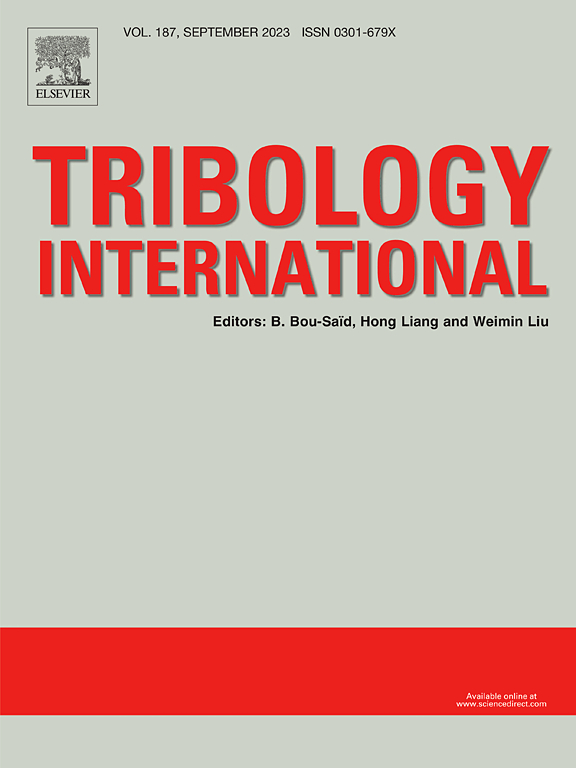Synergistic anti-wear performance of TiO2 nanoparticles and ZDDP: Influence of dispersion methods
IF 6.1
1区 工程技术
Q1 ENGINEERING, MECHANICAL
引用次数: 0
Abstract
Zinc dialkyldithiophosphate (ZDDP) remains a cornerstone anti-wear additive in lubricants, particularly in applications demanding extreme boundary lubrication performance. However, emerging challenges in electric vehicle (EV) transmissions, such as higher available torque at standstill and lower lubricant viscosity, necessitate advanced formulations. Metal oxide nanoparticles, particularly anatase TiO2, have demonstrated potential to enhance wear protection through the formation of protective tribofilms. This study investigates the benefits of combining TiO2 nanoparticles with ZDDP in mitigating wear under boundary conditions. We evaluate the impact of dispersion methods, including oleic acid-based physical dispersion and chemical functionalization, on the tribological performance of these hybrid formulations. Using a combination of ball-on-disc tribological testing, profilometry, scanning electron microscopy (SEM), energy-dispersive X-ray spectroscopy (EDX), and X-ray photoelectron spectroscopy (XPS) analyses, we demonstrate a synergistic effect between ZDDP and TiO2 nanoparticles, delivering superior wear protection and friction reduction compared to individual components, regardless of dispersion method. However, chemically functionalized TiO2 outperforms physically dispersed nanoparticles by forming a thicker and more uniform anti-wear tribofilm. These findings highlight the potential for hybrid lubricant formulations to meet the demands of advanced automotive applications.
TiO2纳米粒子与ZDDP协同抗磨性能:分散方式的影响
二烷基二硫代磷酸锌(ZDDP)仍然是润滑剂中抗磨添加剂的基石,特别是在要求极限边界润滑性能的应用中。然而,电动汽车(EV)变速器面临的新挑战,如静止时更高的有效扭矩和更低的润滑油粘度,需要先进的配方。金属氧化物纳米颗粒,特别是锐钛矿TiO2,已经证明了通过形成保护性摩擦膜来增强磨损保护的潜力。本研究考察了TiO2纳米颗粒与ZDDP结合在边界条件下减轻磨损的好处。我们评估了分散方法,包括油酸为基础的物理分散和化学功能化,对这些混合配方的摩擦学性能的影响。通过结合球盘式摩擦学测试、轮廓测量、扫描电子显微镜(SEM)、能量色散x射线能谱(EDX)和x射线光电子能谱(XPS)分析,我们证明了ZDDP和TiO2纳米颗粒之间的协同效应,与单个组件相比,无论采用何种分散方法,都能提供卓越的磨损保护和摩擦减少。然而,化学官能化的TiO2通过形成更厚、更均匀的抗磨摩擦膜而优于物理分散的纳米颗粒。这些发现凸显了混合润滑油配方在满足先进汽车应用需求方面的潜力。
本文章由计算机程序翻译,如有差异,请以英文原文为准。
求助全文
约1分钟内获得全文
求助全文
来源期刊

Tribology International
工程技术-工程:机械
CiteScore
10.10
自引率
16.10%
发文量
627
审稿时长
35 days
期刊介绍:
Tribology is the science of rubbing surfaces and contributes to every facet of our everyday life, from live cell friction to engine lubrication and seismology. As such tribology is truly multidisciplinary and this extraordinary breadth of scientific interest is reflected in the scope of Tribology International.
Tribology International seeks to publish original research papers of the highest scientific quality to provide an archival resource for scientists from all backgrounds. Written contributions are invited reporting experimental and modelling studies both in established areas of tribology and emerging fields. Scientific topics include the physics or chemistry of tribo-surfaces, bio-tribology, surface engineering and materials, contact mechanics, nano-tribology, lubricants and hydrodynamic lubrication.
 求助内容:
求助内容: 应助结果提醒方式:
应助结果提醒方式:


